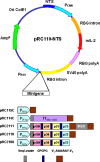DNA vaccination strategies for anti-tumour effective gene therapy protocols
- PMID: 20390416
- PMCID: PMC11030090
- DOI: 10.1007/s00262-010-0853-x
DNA vaccination strategies for anti-tumour effective gene therapy protocols
Abstract
After more than 15 years of experimentation, DNA vaccines have become a promising perspective for tumour diseases, and animal models are widely used to study the biological features of human cancer progression and to test the efficacy of vaccination protocols. In recent years, immunisation with naked plasmid DNA encoding tumour-associated antigens or tumour-specific antigens has revealed a number of advantages: antigen-specific DNA vaccination stimulates both cellular and humoral immune responses; multiple or multi-gene vectors encoding several antigens/determinants and immune-modulatory molecules can be delivered as single administration; DNA vaccination does not induce autoimmune disease in normal animals; DNA vaccines based on plasmid vectors can be produced and tested rapidly and economically. However, DNA vaccines have shown low immunogenicity when tested in human clinical trials, and compared with traditional vaccines, they induce weak immune responses. Therefore, the improvement of vaccine efficacy has become a critical goal in the development of effective DNA vaccination protocols for anti-tumour therapy. Several strategies are taken into account for improving the DNA vaccination efficacy, such as antigen optimisation, use of adjuvants and delivery systems like electroporation, co-expression of cytokines and co-stimulatory molecules in the same vector, different vaccination protocols. In this review we discuss how the combination of these approaches may contribute to the development of more effective DNA vaccination protocols for the therapy of lymphoma in a mouse model.
Figures



Similar articles
-
Electroporation in DNA vaccination protocols against cancer.Curr Drug Metab. 2013 Mar;14(3):291-9. doi: 10.2174/1389200211314030004. Curr Drug Metab. 2013. PMID: 23116110 Review.
-
The potential of DNA vaccination against tumor-associated antigens for antitumor therapy.Exp Biol Med (Maywood). 2002 Apr;227(4):227-37. doi: 10.1177/153537020222700403. Exp Biol Med (Maywood). 2002. PMID: 11910045 Review.
-
Application of electroporation in DNA vaccination protocols.Curr Gene Ther. 2010 Aug;10(4):281-6. doi: 10.2174/156652310791823506. Curr Gene Ther. 2010. PMID: 20504275 Review.
-
[Novel vaccines against M. tuberculosis].Kekkaku. 2006 Dec;81(12):745-51. Kekkaku. 2006. PMID: 17240920 Review. Japanese.
-
Idiotypic vaccination for B-cell malignancies as a model for therapeutic cancer vaccines: from prototype protein to second generation vaccines.Haematologica. 2002 Sep;87(9):989-1001. Haematologica. 2002. PMID: 12217812 Review.
Cited by
-
Effects of trehalose polycation end-group functionalization on plasmid DNA uptake and transfection.Biomacromolecules. 2012 Aug 13;13(8):2229-39. doi: 10.1021/bm300471n. Epub 2012 Jul 18. Biomacromolecules. 2012. PMID: 22616977 Free PMC article.
-
Vaccines targeting the neovasculature of tumors.Vasc Cell. 2011 Mar 8;3(1):7. doi: 10.1186/2045-824X-3-7. Vasc Cell. 2011. PMID: 21385454 Free PMC article.
-
Clinical trials of dendritic cell-based cancer vaccines in hematologic malignancies.Hum Vaccin Immunother. 2014;10(11):3125-31. doi: 10.4161/21645515.2014.982993. Hum Vaccin Immunother. 2014. PMID: 25625926 Free PMC article. Review.
-
Analysis of physical and biological delivery systems for DNA cancer vaccines and their translation to clinical development.Clin Exp Vaccine Res. 2024 Apr;13(2):73-82. doi: 10.7774/cevr.2024.13.2.73. Epub 2024 Apr 30. Clin Exp Vaccine Res. 2024. PMID: 38752006 Free PMC article. Review.
-
A novel adjuvant Ling Zhi-8 enhances the efficacy of DNA cancer vaccine by activating dendritic cells.Cancer Immunol Immunother. 2011 Jul;60(7):1019-27. doi: 10.1007/s00262-011-1016-4. Epub 2011 Apr 17. Cancer Immunol Immunother. 2011. PMID: 21499904 Free PMC article.
References
-
- Buchan S, Grønevik E, Mathiesen I, King CA, Stevenson FK, Rice J. Electroporation as a “prime/boost” strategy for naked DNA vaccination against a tumor antigen. J Immunol. 2005;174:6292–6298. - PubMed
Publication types
MeSH terms
Substances
LinkOut - more resources
Full Text Sources
Other Literature Sources
Medical

